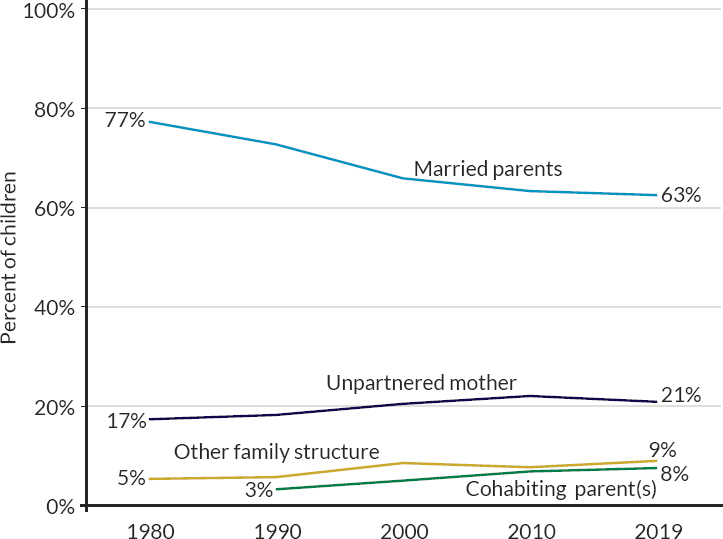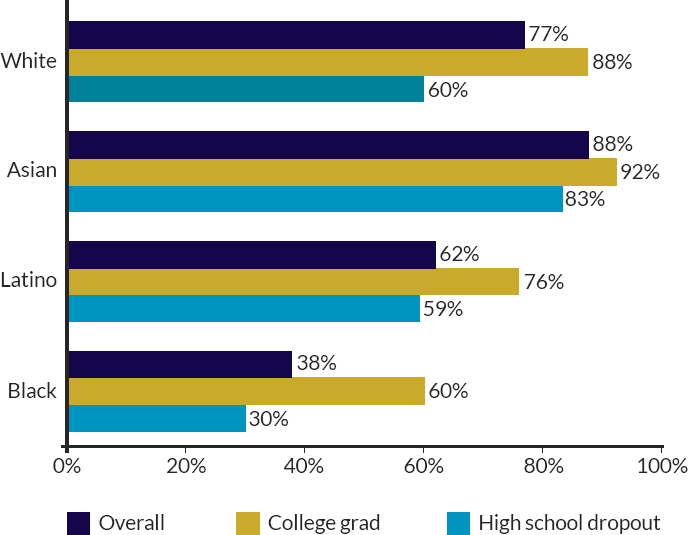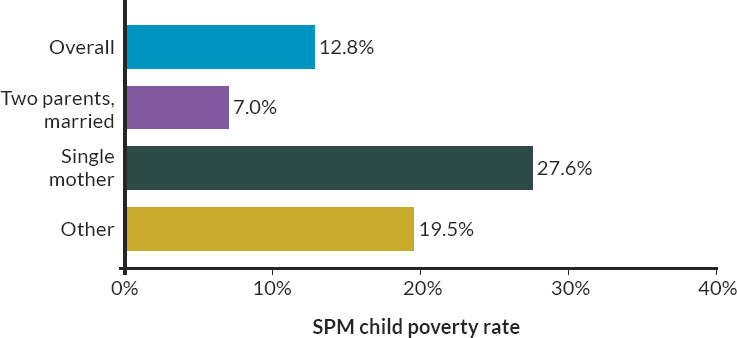7
Children’s Family Structure
Trends in child poverty over the past half century have been shaped by a number of demographic changes (National Academies, 2019a, Chapter 4). Increases in both educational attainment and employment among low-income mothers, coupled with reductions in teen births, have lowered the child poverty rate. At the same time, the declining share of children living with married parents has led to an increase in child poverty. Much less is known about the impact of these demographic factors on the subject of this report—intergenerational poverty.
For several reasons, this chapter focuses on family structure as a possible driver of intergenerational poverty. First, significant changes have taken place in the structure of families with lower levels of schooling and in Black families. Second, there has been voluminous research linking family structure during childhood to intergenerational outcomes such as completed schooling. And third, some recent research suggests that family structure at the neighborhood level might influence intergenerational outcomes, independently of the structure of children’s immediate families.
TRENDS IN FAMILY STRUCTURE
The share of children living in homes with married parents has fallen considerably over the past five decades, dropping from 77% in 1980 to 63% four decades later (Figure 7-1). Most of the decline had occurred by the turn of the millennium. Increases in family structures characterized by unpartnered mothers, cohabiting parents, or more complex arrangements

NOTES: A married-parent family is defined as a living arrangement in which the child’s mother and father are married and present in the home, a mother and her married spouse are present in the home, or a father and his married spouse are present in the home. This includes biological parents, step-parents, adoptive parents, and both same- and opposite-sex married couples. An unpartnered-mother household is defined as one in which a mother is present in the household, but no other parental figure is present in the household. A cohabiting parent(s) household is defined as one in which a child’s mother or father and an unmarried partner are present in the household.
SOURCE: Adapted from Figure 1 in Kearney (2022) and based on data from the American Community Survey.
have all contributed to a decline in the fraction of children living with married parents.
Family structures differ markedly by race/ethnicity and education levels. The dark bars in Figure 7-2 show that in 2019, the largest proportions of children living with both married parents could be found among Asian children (88%), followed by White (77%) and Hispanic (62%) children, while only 38% of Black children were living with married parents (Kearney, 2022). All these fractions are considerably lower than they had been
four decades earlier. In the case of White, Hispanic, and Black children, rates of married-parent family structures were all more than 10 percentage points higher in 1980 than in 2019.
Rates of married-parent family structures are also markedly different across maternal education levels. Figure 7-2 shows differences between mothers with college degrees and mothers who had not completed high school; more complete data can be found in Kearney (2022). Rates of married-parent family structures are 28 percentage points higher for White college graduates than White high school dropouts. Corresponding differences amount to 17 percentage points for Hispanic children, 30 percentage points for Black children, and 9 percentage points for Asian children.

NOTES: A married-parent family is defined as a living arrangement in which the child’s mother and father are married and present in the home, a mother and her married spouse are present in the home, or a father and his married spouse are present in the home. This includes biological parents, step-parents, adoptive parents, and both same- and opposite-sex married couples.
SOURCE: Adapted from Figure 4 in Kearney (2022) and based on data from the American Community Survey.
Children reared in single-parent homes are much more likely than other children to be living in poverty. In 2019, 8% of children living in homes with married parents had family incomes below the Supplemental Poverty Measure (SPM) poverty line, compared with more than a quarter of children living with single mothers (Figure 7-3). It is important to note that, at least in the United States, what seems to matter is that parents are married and not merely cohabiting, as marriage tends to be associated with greater stability. Among nonmarried, cohabiting couples, the probabilities of family dissolution before a child turns 12 for parents with a high school education or less, some college, or a bachelor’s degree or more were 41%, 45%, and 49%, respectively, between 2006 and 2010. For married parents, those probabilities were 26%, 27%, and 18% (Strain et al., 2022).

NOTES: SPM poverty rates apply to the calendar year 2019 as reported in the March 2020 Current Population Survey. Estimates produced with the Census Bureau’s public-use weights, which adjust for survey nonresponse related to the COVID-19 pandemic. See Rothbaum and Bee (2021) for additional details regarding these weights. We identified the marital status of children’s parents by linking them to their parents and then determining their parents’ marital status. “Two-parent, married” includes children living with both of their parents who are married to each other. “Single mother” includes children living with their mother, and their mother is neither married nor cohabiting. Children in all other family types are in the “other” category.
SOURCE: Data from the Annual Social and Economic Supplement to the Current Population Survey data from IPUMS-CPS (2022).
FAMILY STRUCTURE AND INTERGENERATIONAL CHILD WELL-BEING
Many studies have found that children growing up in families with two married parents tend to fare better during both childhood and adulthood. Children raised in married-parent homes earn higher grades and are less likely to be suspended from school (Autor et al., 2016; Kearney & Levine, 2017; Tillman, 2007). Living in a married-parent home is positively associated with completing high school and both attending and graduating from college (Kearney & Levine, 2017). These correlates are all linked to skill acquisition, which itself is associated with better adult economic outcomes.
In their study of intergenerational outcomes, Lopoo and DeLeire (2014) found that children growing up in stable married households completed 1.6 more years of schooling than other children. In addition, they found that these children’s adult family incomes were $52,000 higher than those of children in families with never-married parents. Differences in these intergenerational outcomes were smaller, yet still notable, when children in stable married families were compared with children who were born into married-couple families but experienced marital dissolution while they were growing up. Indeed, the effects of divorce may offer a window into the benefits of marriage. Gruber (2004) found that adults who, as children, experienced the easing of legal requirements for divorce were less well educated, had lower family incomes, separated from a partner more often, and were at higher risk of suicide than those who had grown up in areas that had maintained stricter divorce laws.
An obvious possible reason why married-parent family structure is associated with better child outcomes is that having two adults in the home means twice as many potential income earners relative to single-parent families. Hastings and Schneider (2021) find this pattern of income differences in the Consumer Expenditure Survey data and go on to show that families with married parents spend nearly twice as much on enrichment goods and services (e.g., daycare centers, private-school tuition, lessons, and other extra-curricular activities) for their children than either cohabiting or single parents. Family income accounted for virtually all of these expenditure differences between married and single parents but, interestingly, for only about half of the differences between married and cohabiting parents.
Chen et al. (2009) found that wages and educational attainment (among other outcomes) are negatively associated with growing up in a single-mother household. When they control for income, the association between growing up in a single-mother household and later-life outcomes of youth falls by one-third to one-half. On the other hand, conditional on
parent income, Chetty et al. (2020) find little association between children’s adult earnings and their parents’ marital status.
If parental family income explains most of the associations between family structure and intergenerational outcomes, this does not imply that differences in child outcomes would disappear if families without two married parents in the home were simply given more money. Factors associated with a married, two-parent family structure, such as stability, a nurturing home environment, health insurance coverage, home ownership, and paternal involvement, may have independent effects on intergenerational mobility (Ribar, 2015). Marriage increases the likelihood that these factors will be present in the home. Even after holding them constant, however, Ribar (2015) found a direct positive association between child well-being and marriage. Children growing up in a two-parent home may also enjoy substantially more time with a parent (Hamermesh, 2022), which could complement parental financial investments (Lundberg & Pollak, 2014).
DOES FAMILY STRUCTURE AFFECT INTERGENERATIONAL MOBILITY?
Associations between family structure and longer-run outcomes, even after adjustments for income and other demographic differences, do not prove that family structure itself is the active ingredient. Estimating the causal effect of marriage on child outcomes, including intergenerational poverty, is notoriously difficult because the true causes may lie in unmeasured differences across family types, rather than in family structure itself.
In their review of the evidence on the effects of a father’s absence, McLanahan et al. (2013) report that the most rigorous studies tend to show detrimental impacts on child outcomes, although the impacts are smaller than those suggested by correlational studies. They argue that the most convincing evidence of impacts concerns high school graduation and adult mental health. The review by Kearney and Levine (2017) observed that while no study yields truly convincing causal evidence, the persistence of impacts across so many different kinds of studies is, in their words, “strongly suggestive of a causal relationship.”
A notable recent working paper by Pope et al. (forthcoming) uses data from U.S. Census and tax records to compare siblings who experience a parental divorce at different ages to estimate the effect of the duration of living in a post-divorce household on children’s adult outcomes. These researchers find that the changes in family structure associated with divorce lead to reductions in adult earnings and college attendance and increases in teen births and incarceration. Exposure to divorce prior to age 11 is associated with a reduction of greater than 6% in children’s family income in adulthood. In addition, Pope et al. (forthcoming) find larger effects for
children who experience a divorce at younger ages and children of low-income families.
Neighborhood Differences in Family Structure
Thus far, we have concentrated on the structure of a child’s immediate family. As described in Chapter 2, however, the Chetty et al. (2014) correlational study of intergenerational mobility finds lower mobility for low-income children in neighborhood areas with a large fraction of single parents in the neighborhood. Family structure appears to operate independently at the family and neighborhood levels; for example, children of single parents have higher rates of upward intergenerational mobility if they grow up in a neighborhood with fewer single-parent households. Importantly, this study also controls for household income.
Chetty et al. (2020) find that these neighborhood effects are particularly strong for Black males. While differences in family characteristics explain little of the Black-White income gap across generations, there is a striking association between Black father presence in neighborhood and second-generation outcomes for Black males. Although not a causal study, the specific nature of these correlations rules out broad mechanisms that would affect both genders and races (such as differences in the quality of schools). Instead, it points to channels that affect Black boys in particular, such as mentoring by Black male role models in the community or differences in the way Black men are treated by their peers and adults in areas where Black fathers are involved in their children’s households.
Incarceration and Family Structure Differences
A possible cause of trends toward single-parent family structures is the striking increase in incarceration over the last quarter of the 20th century (National Research Council, 2014; Wilson & Neckerman, 1986). Lopoo and Western (2005) found sharply lower rates of first marriage among individuals who have been incarcerated, and they observed that negative associations between incarceration and marriage are stronger for White men than for either Hispanic or Black men. However, simulations based on their correlational evidence show that marriage rates for Black men would change very little in the absence of incarceration. This is consistent with the analyses of Schneider et al. (2018), which finds that prior incarceration accounts for only about 8% of the decline in marriage rates among Black men. The more general conclusion of Lopoo and Western (2005) is that men at risk of imprisonment are very unlikely to marry, whether or not they are actually incarcerated.
Conclusion 7-1: Single-parent families have become much more prevalent over the past 50 years, though largely among parents who lack community college or 4-year college degrees. Rising rates of incarceration account for some but not most of these trends. There is a strong association between growing up in a single-parent family and low-income status in adulthood. Evidence on causal links between growing up in a single-parent family and being poor as an adult is strongly suggestive.
FAMILY STRUCTURE INTERVENTIONS
A number of social policies might influence the decisions that teens and adults make about family composition, but recent reviews conclude that the existing literature on marriage incentives and disincentives provides little reason to believe that current social policies have had a substantial impact (e.g., National Academies, 2019a, Chapter 7).
An alternative approach to promoting married, two-parent families is to develop interventions that are specifically intended to increase the share of children living in two-parent households (Haskins, 2015). An ambitious attempt to develop and evaluate a number of such programs was undertaken during the George W. Bush administration, but recent reviews have concluded that all failed to boost marriage rates or improve longer-run child well-being (National Academies, 2019a, Chapter 7). A recent metaanalysis of clinical trials of a broader range of education programs designed to improve couple relationships showed modest but statistically significant impacts on relationship skills and quality, but not on the key family-structure outcome: the stability of the relationship (Hawkins et al., 2022). These results do not prove that couple relationship programs are without value—but simply that we have not yet discovered a program model that, if scaled up, is actually effective at promoting married, two-parent families.
Conclusion 7-2: While it appears that married, two-parent family structures may, in fact, reduce intergenerational poverty, we lack direct evidence of policies and programs that are capable of promoting such structures.








